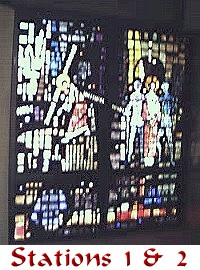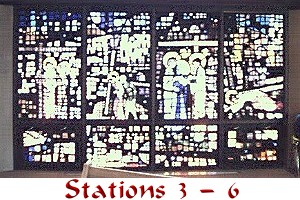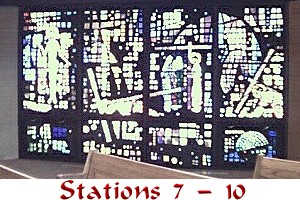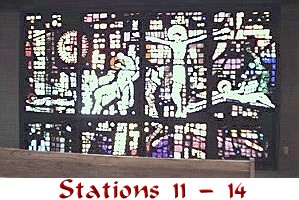|
Stations
of the Cross
These Internet Stations
have been designed to help you walk in the footsteps
of Jesus. Some of us have a hard time getting out,
so they can provide a wonderful opportunity for
us to pray the stations at home. We might gather
the family and pray them together, and perhaps even
print some copies. Our hope is that they encourage
you to go to Church and pray the Stations there
too, when you can.
Where did the Stations
of the Cross come from? After Jesus died and rose
from the dead, many people reflected upon his passion
and death. They began to make visits to Jerusalem
and walk in Jesus' footsteps. The street Jesus walked
is still called Via Dolorosa, the way of pain. People
would stop along the way and remember what had happened
to Jesus. It is likely that they marked the places
for those who came after them to follow as well.
 These people became known as "pilgrims." These people became known as "pilgrims."
As Christianity spread
throughout the know world, distance made it nearly
impossible for people to make the trip to Jerusalem.
That didn't stop their need to know and remember.
By the twelfth century the fervor of the Crusades
and a heightened devotion to the Passion of Jesus
crated a demand in Europe for representations of
the last events in Jesus' life.
When the Franciscans
took over the custody of the shrines in the Holy
Land in 1342, they saw it as their mission to encourage
devotion to these places. In western Europe
a series of shrines erected to help the faithful
remember Christ's passion became  commonplace. They
were erected outside Churches and monasteries and
in other places as well. For many years there was
a considerable variety in the number and title of
these "stations." The current number
of fourteen first appeared in the Low Countries
in the sixteenth century and became standard in
the eighteenth century with a series of papal pronouncements. commonplace. They
were erected outside Churches and monasteries and
in other places as well. For many years there was
a considerable variety in the number and title of
these "stations." The current number
of fourteen first appeared in the Low Countries
in the sixteenth century and became standard in
the eighteenth century with a series of papal pronouncements.
The chief promoter
of this devotion was the Franciscan Leonard of Port
Maurice [died 1751], who set up more than five hundred
sets of stations, the best know being the one in
the Coliseum of Rome. Modern liturgists have
emphasized that devotion to the Passion is incomplete
without reference to the Resurrection and have thus
fostered the addition of a "fifteenth station,"
the Resurrection of Jesus.
 The Season of Lent
is a natural time for this devotion. As the years
passed, many Catholic Churches had the Stations
of the Cross along the walls of their worship space.
At St. John's, the Stations are represented in the
colorful glass windows at the back of our church.
"Pilgrims" can come to Church any time,
pray and move from station to station. Perhaps tell
your children that the Stations of the Cross are
like railroad stations because we stop at every
one. The Season of Lent
is a natural time for this devotion. As the years
passed, many Catholic Churches had the Stations
of the Cross along the walls of their worship space.
At St. John's, the Stations are represented in the
colorful glass windows at the back of our church.
"Pilgrims" can come to Church any time,
pray and move from station to station. Perhaps tell
your children that the Stations of the Cross are
like railroad stations because we stop at every
one.
The purpose of the
Stations of the Cross is to remind us of the effects
of sin and the salvation won for us through the
suffering, death and resurrection of Jesus. As we
meditate on the Stations, we are moved to renounce
sin and to accept Jesus as our Savior.
So let's begin our
"walk" with an opening
prayer...
|